The Chinese drum is an integral part of Chinese culture and has a long history of service at public events. Different sizes, shapes, and styles give them distinctive sounds that are easily distinguishable from one another. This page will introduce you to Chinese drums, including topics such as their names, construction, purposes, types, symbolism, and playing techniques.
What is a Chinese drum called?
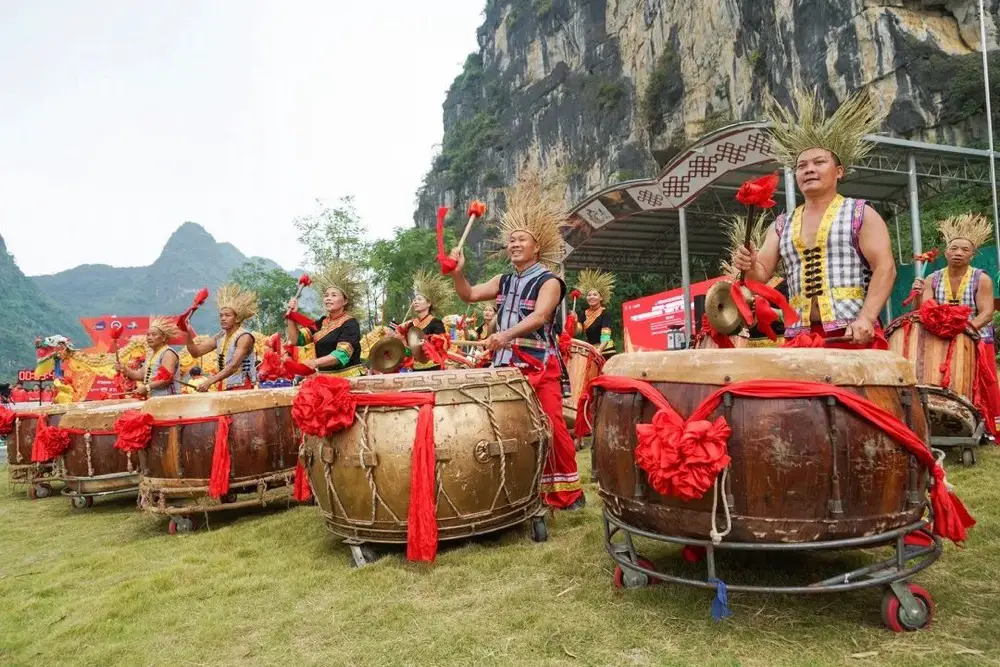
One of the oldest percussion instruments in China is the Chinese drum. The great drum, the little drum, and the lion dance drum are all included under the umbrella name “gu” (鼓) in Mandarin Chinese, which describes a variety of drums used in traditional Chinese music.
A massive, barrel-shaped drum with a deep, resonant sound, the big drum is also known as the da gu. Traditional Chinese opera and the dragon dance both feature it prominently as part of a larger ensemble performance. Sometimes referred to by its Chinese name, “xiao gu,” the little drum is a higher-pitched instrument with a more piercing, staccato tone. Many different styles of Chinese music (including folk songs, ballads, and instrumental music) feature or are accompanied by the erhu.
A special kind of drum, the “fo gu” (or “lion dance drum”), is played exclusively during lion dance performances. This is a style of Chinese performance art that is typically seen around the Lunar New Year and other celebrations. The drum used in lion dances is often much smaller than the main drum, and its drumhead is flat and decorated with brightly colored designs and symbols.
Many other types of Chinese percussion instruments, such as cymbals, gongs, and woodblocks, are often played alongside the Chinese drum. When played together, these instruments produce a dynamic, intricate sound that is distinctive to Chinese music.
What is a Chinese drum made of?
The kind and function of a Chinese drum dictate the materials used in its construction. Wood, animal leather, and metal are common components of traditional Chinese drums.
The shell is the drum’s main component and is often composed of wood. Bamboo, mulberry, and paulownia wood were commonly used in the construction of traditional Chinese drums. Hardwoods like maple, birch, and oak are now the go-to materials. Drums are hand-made by selecting wood for its acoustic qualities and then shaping it into the appropriate form.
The drumhead (or drum skin) is what makes noise when the drum is hit. Cowhide, goatskin, and water buffalo skin are common materials for this. There are ropes or metal hoops used to secure the skin over the drum shell. Variations in skin tension and thickness allow for a wide tonal and dynamic range.
When playing a drum, the drumstick (or drum mallet) is used to hit the drumhead and create sound. Drumsticks in Chinese music are often constructed of bamboo or a strong wood like hickory or oak. The type of drum and the intended sound can also dictate the size and shape of the drumstick.
Certain Chinese drums may additionally have elaborate decorations and symbols that speak to their cultural significance in addition to the more basic features listed above. The drum used in a lion dance, for instance, might feature dragons, lions, or some other classic Chinese motif. Colorful silk covers and tassels may be used to decorate the large drum used in classical Chinese opera.
What are Chinese drums used for?
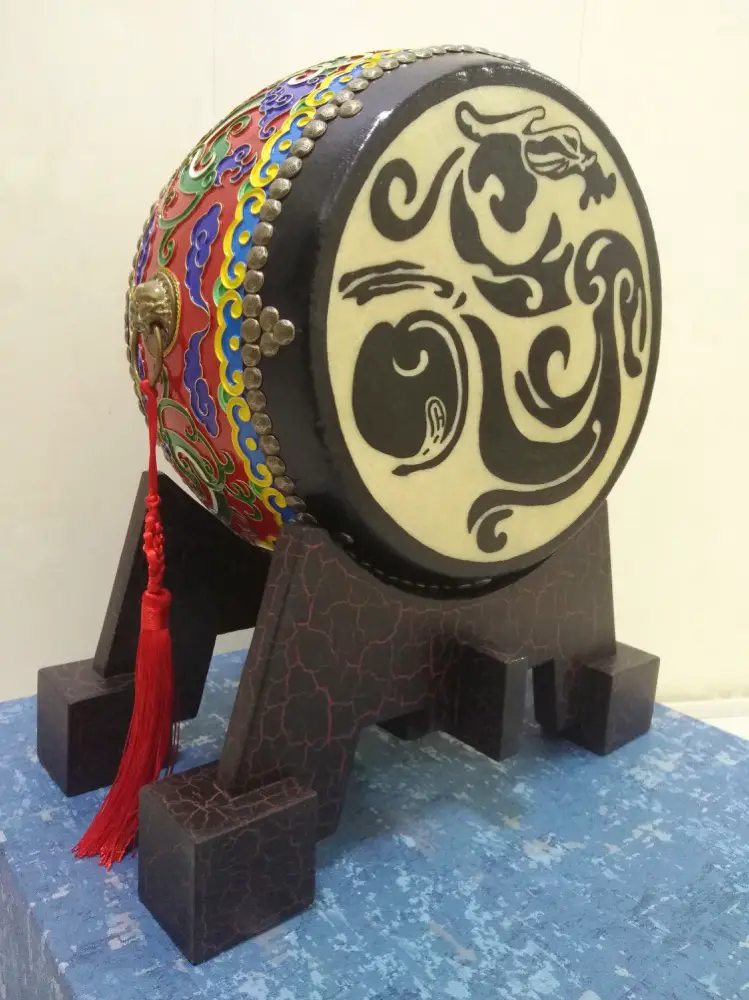
In traditional Chinese culture, drums are used for a variety of purposes, from musical performances to religious rituals and celebrations. It is widely held that playing and listening to the drums creates a sense of unity and peace in both the player and the listener. Some of the most typical applications of Chinese drums include:
The Chinese drum is an integral feature of classical Chinese music. They are utilized in many forms of music, including opera, folk music, instrumental music, and dance. Several styles of Chinese drumming exist for different drums, different-sized drums, and different tones. In Chinese opera, for instance, the large drum is utilized to denote pivotal points in the plot, while the smaller drum is played by soloists to set the tempo and highlight melodies. The guzheng, erhu, and pipa are just a few examples of instruments that benefit from having Chinese drumming as an accompaniment (lute).
The Lion and Dragon Dance: During Chinese New Year and other celebrations, the lion and dragon dance is a common sight in China. The rhythmic pulse provided by Chinese drums is crucial to the movement of the lion or dragon in this dance. The lion dance drum, unlike the large drum, generates a harsh, staccato sound meant to evoke the roar of a lion.
Ceremonies of the Taoist and Buddhist faiths make frequent use of Chinese drums. It is claimed that listening to the steady beat of a drum will put one in a meditative state where one can feel closer to God. In Taoist rites, for instance, the drum is played to invoke the gods and deities and foster a sense of spiritual harmony.
Chinese drums are frequently utilized in festivities and festivals because of their ability to generate a joyful and celebratory mood and to unite people. Large processions with drums, cymbals, and gongs are commonplace in many Chinese festivals, such as the lantern festival that ushers in the New Year. Drum performances and dragon dances are common at the Mid-Autumn Festival, another major Chinese event.
There is a long history of military and martial arts use of Chinese drums. On the battlefield, the drum’s steady beat was utilized to transmit orders and keep the men in sync. The drum served as a training aid and performance accompaniment in traditional martial arts.
A big drum would often be displayed outside of administrative buildings in ancient China atop a drum tower or drum platform. A “complaints drum” or “appeals drum” was used by the people to express their displeasure with the government.
One would come to the drum tower and beat the drum to get the attention of the authorities when they had a problem or complaint they wanted addressed. Government officials would respond to the beat of the drum by sending an official out to investigate the source of the complaint.
The complaint drum was a vital means through which the people could make their opinions heard by the government. It represented the right of citizens to make complaints to and demand answers from their government. The drum also served as a constant reminder to government officials that their first responsibility was to the people.
The complaints drum is an icon of old Chinese culture that is still played in some communities today. Although it was formerly widely used, it has since been mostly superseded by more efficient channels for voicing dissatisfaction with the government.
Who invented the Chinese drum?
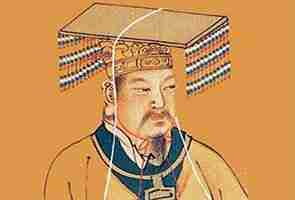
While the Chinese drum has been a part of Chinese culture for hundreds of years, its exact origin is unknown. The history and development of the Chinese drum are shrouded in mystery, although there are numerous stories and historical narratives that seek to explain them.
The Song Dynasty’s (960–1279 CE) Book of Music, which chronicles the use of drums in ancient Chinese music, is one of the first written records of the Chinese drum. A minister named Qibo, who served the Yellow Emperor between 2697 and 2597 BCE, is credited in the book with inventing the drum. Legend has it that Qibo invented a new kind of music by crafting a drum from the skin of a sacred animal.
During the Han Dynasty (206 BCE–220 CE), a guy named Yu Boya, who was also a superb musician and drummer, is mentioned in another narrative regarding the genesis of the Chinese drum. The tradition claims that Boya’s drumming was so rousing and rhythmic that it caused earthquakes and other natural disasters. According to alternate accounts of the mythology, Boya either developed the drum or was inspired to construct one by the sound of thunder.
Although its precise history is lost to time, the Chinese drum has always been an integral part of Chinese culture. Not only in the realm of martial arts and the military but also in other cultural traditions such as music and dance. The drum has also served as a means of communicating with the gods and the spirits of the ancestors in traditional Chinese religion and culture.
The Chinese drum has exploded in popularity in recent decades and is now often featured in live performances by a wide variety of artists and dancers from all over the globe. In addition, it has made its way into movies, TV series, and games.
Different types of Chinese drums
The Chinese drum has a long and illustrious history, and its many applications range from musical and dancing performance to military and martial arts. There have been many variations on the Chinese drum over the years, each with its own distinct sound and function. The most popular styles of Chinese drums are as follows:
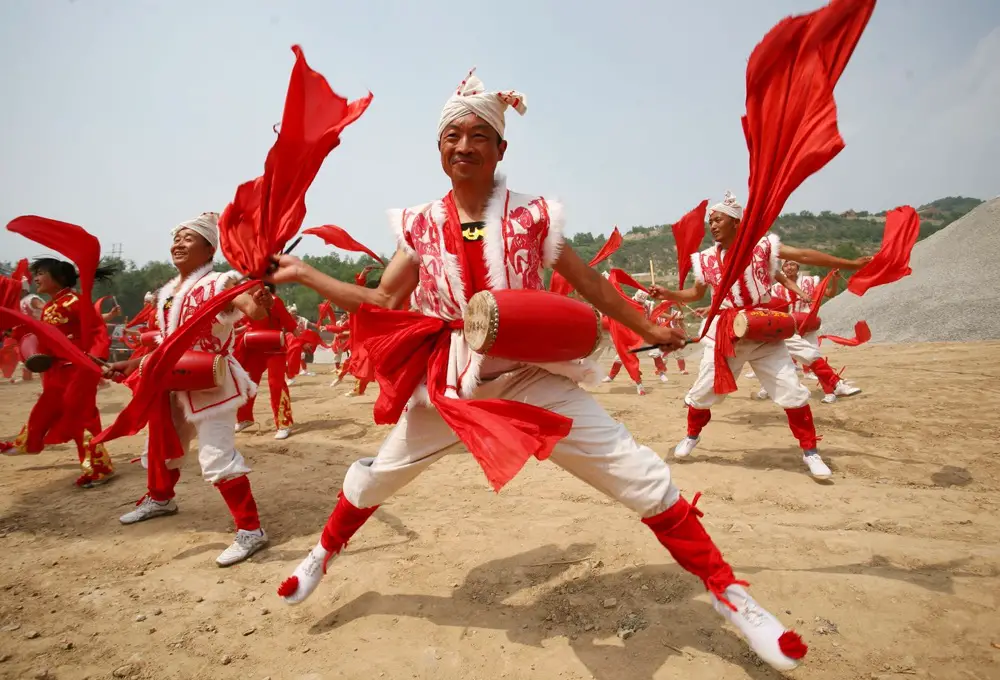
The waist drum is thought to have descended from the Jiegu drum and to have first gained popularity around the year 400 AD. Tang dynasty waist drums were referred to as either “Zhenggu” () or “Hegu” () depending on their function in the show. The waist drum, in its modern form, has been played in shows like “Fengyang Huagu,” “Huagu Deng,” and “Huaibei Huaguxi” since the Ming Dynasty.
The waistband is a cylinder that tapers at the ends and is thicker in the middle. The drum body consists of two iron rings that are suspended from straps around the waist, and its ends are covered with skin. The drum is struck with a wooden mallet held in each hand. The waist drum’s pitch is variable, and its sounds are crisp and clear. It’s versatile enough to serve as both a musical instrument and a stage prop, allowing you to create a wide variety of joyful and celebratory settings. The waist drum is the star of a waist drum ensemble.
The Wolf Tent Drum, or “Liangzhang Drum,” is a musical instrument well-liked in Fuzhou. Similar in appearance to the long drum played by members of the Korean ethnic group, the wolf tent drum evolved from ancient narrow waist drums. The length of the wooden drum body is roughly 70 cm. Both ends are bulky and hollow, while the center is relatively small. The drumhead has a diameter of about 30 cm and is covered on both sides with cowhide or python skin. Drum skins are traditionally strung over a metal hoop and held taut with ropes. Either a wooden mallet or a person’s bare hands can be used to play it. One of the “Fuzhou Ten Series” centerpiece instruments, this one is frequently heard in Min opera ensembles.
The Fisherman’s Drum, also called a Bamboo Qin or a Dao Tong, was a musical instrument played by fishermen in southern China during the Song dynasty. These days, a bamboo tube measuring 65 to 100 cm in length and 13 cm in diameter is sleeved with pigskin or sheepskin to create the modern fisherman’s drum. The drum is held securely in the left hand, and the right hand is used to hit the drum. Daoqing, Yugu, and Zhuqin are three types of traditional Chinese music and theater in which it plays a pivotal supporting role.
The Chinese bass drum is one of the most ubiquitous percussion instruments in a wide range of musical and cultural settings. It’s usually quite big, and its sound is deep and resonant, so it’s used to lay down a steady rhythm for other instruments or performers to play over.
The tiny drum, often called a snare drum or side drum, is a type of high-pitched drum typically heard in military and marching bands. The sound is clean and tight, and it’s typically played at a fast tempo.
Little and resonant, the opera drum is a staple of classical Chinese opera. Its edgy, piercing tone is employed to emphasize dramatic or musical turning points.
The taiko drum is not indigenous to China, but it has gained popularity there and is now frequently featured in cultural events and festivals. The sound of this massive barrel-shaped drum, played with sticks, is deep and resonant.
The huge, low-pitched drum known as a temple drum is commonly heard during ritual and religious ceremonies. This music is meant to induce a state of calm and introspection with its slow, steady beat.
The big, low-pitched drum known as the “war drum” was traditionally played to motivate troops before battle and strike fear into the hearts of the enemy. The sound from it travels great distances because of its intensity and volume.
As its name suggests, the dragon drum is a bass drum with a dragon design. Because of its supposed ability to bring forth prosperity and good fortune, it is frequently used in religious and cultural celebrations.
A lion drum is a tiny drum typically played during a lion dance performance. The lion dancers’ motions are accompanied by the instrument’s bright, energetic sound.
The hand drum is a small, handheld drum that is played with the hands or fingers. Folk music and dance, as well as religious and ceremonial settings, are frequent users of this term.
The “Hua Pen Gu” (Flower Pot Drum) is a variation on the “Tang Gu” drum that gets its name from the resemblance of its shape to a flower pot. Chinese operas, dance accompaniment, ensemble performances, and even solo performances frequently feature it. The drum’s body is constructed out of wood (usually camphor, poplar, or willow) and stands at 60 centimeters in height with a 57-centimeter top diameter and a 28.5-centimeter bottom diameter. Drumheads can be crafted from either water buffalo skin or cowhide, with the latter being the more ideal material for the top drum. The drum is played with wooden drumsticks and has a sound that is at once deep and resonant as well as more subdued than that of the “Tang Gu” drum. The drumhead has a wide tonal range.
The Big Tang Drum, or “Da Tang Gu” for short, is a big drum featured heavily in traditional opera, dance, and other forms of group performance. The body of this instrument is crafted from camphor, birch, or poplar wood, while the drumhead is often constructed from the skin of a water buffalo. The drum has a deep, sonorous sound and is played with two drumsticks. It plays a pivotal role in Chinese drum ensembles as the main percussion instrument. It served important functions in ancient societies, including as a timepiece, in religious rites, and in war.
The “Shu Gu” (Book Drum) is a miniature drum with a spherical body that has been flattened out. It is 22 centimeters in diameter and 8.5 centimeters in height. Animal skin is used for both of the drum’s drumheads, and only one drumstick is required for play. The drum, which has a deep, bassy tone, is traditionally played in the background during folk art performances and northern Chinese tale-telling. It also works well as an accompanist for a wide range of vocal performances.
Southern Jiangsu has been a hotspot for Dian Gu, or Huang Gu, since the early 16th century. It has a hard wood frame, like Colorful Wood, and is flat and round in shape. The center is slightly higher than the rest, while the edges slope gently down. The drum’s inside is lined with cowhide on both sides and secured with drum nails that are only a few millimeters apart. The “qianzi” drumstick is constructed of either red wood or bamboo.
The drummer performs while resting the drum on his or her right knee, with the facing side facing the audience. The drummer keeps the drum steady by pressing their right wrist on its top edge, and then they use their thumb, index finger, middle finger, and ring finger to hit the drum with the drumstick. The clapper falls into the left hand’s palm. It’s commonly employed in group pieces like “Ten-Fan Drum” or to back up singers in Kunqu opera. The drum is usually hit once per beat to keep the music steady.
Zhan Gu: The flat drum gets its name from its resemblance to the larger drum, to which it is structurally similar. Although its tone is lower than that of the Tang, it is nevertheless rather powerful. For example, a flat drum with a diameter of around 1 meter and a drum body that is only 20 centimeters high may be found in the Yonghe Temple, which was founded in Beijing in 1723 and was utilized for religious music at the time. Currently, its most common applications are in folk ensemble music and dance, lantern festivals, acrobatic troupes, and drum and gong teams.
The Ban Gu (or “single-skin” or “Ban Drum”) is the traditional Chinese opera orchestra’s conducting instrument. It is typically played by a single player accompanied by a clapper. During the Tang Dynasty (618–907), it was known as “jie gu,” and it was already being employed in “qing yue” (pure music).
The Ban Gu’s distinctive build allows it to produce a sound that is both clean and sharp. As the art of Ming and Qing opera evolved, it was passed down through the generations and eventually became standard accompaniment and ensemble music for regional operas such as Kunqu, Peking Opera, Pingju Opera, Yue Opera, Han Opera, Yu Opera, Hebei Bangzi, Shandong Bangzi, Shaanxi Bangzi, Shandong Liu Zi, and many more. It’s great for groups or can be performed individually (such as the Fast Ban Gu in the Su-Nan wind and percussion music). Whether performing solo or in an ensemble, it often takes the roles of conductor and soloist. In addition to using a variety of striking postures and sounds to signal the entrance and exit of characters, the beginning and ending of songs, and the introduction and elimination of subplots, the clapper is used to beat the rhythm in Peking Opera music, which serves to embellish the drum and gong performances and to create a more vibrant and memorable stage environment and more vivid mental images of the characters performing.
The board drum is a tiny, one-headed drum typically crafted from hard woods like birch, elm, mulberry, or zelkova. With a diameter of 25 centimeters and a drumhead that vibrates and creates music within only 5 to 10 centimeters of the center, this instrument’s body is fashioned from five strong wooden boards. The drum chamber measures 9.5 cm in height along its edge, and it has the shape of a number eight. The cowhide drumhead is stretched taut across the board to the very edge. The pitch of a board drum is determined by the size of the drum chamber and the tension of the drumhead. Many drum nails and a ring of iron around the base are employed to keep the drumhead taut.
Depending on the production, the board drum’s drum chamber can be huge, medium, or small. The bottom diameter of the little chamber board drum is 23.5 centimeters, and its diameter at the center is 11.5 centimeters. Its high, clear tone is a staple in Beijing opera, regional theater, and instrumental groups. The huge board drum chamber measures 10 cm across, 11 cm high, and 24.5 cm across at its base. Its wide, calm sound is well-suited to the quick drum parts common in southern Shifan Gu music. The bottom diameter of the medium drum chamber board drum is 24 cm, while its central diameter is 8 cm, and its height is 11.2 cm. Yue opera, regional theater from Shaanxi and Shanxi, and instrumental groups often feature this instrument because of its middle ground tone between the large and small chamber board drums.
The board drum is a frameless drum that is hung from a vine or bamboo pole and beaten with a hammer. Point and full strokes, as well as other methods, allow for a wide range of tonalities and pitches to be achieved when playing the drums.
The rank drum is a newly reformed type of drum within the percussion family in China. It draws inspiration from the traditional medium-sized tanggu and waist drums as well as drumming styles from both China and other countries. It has become a staple in national orchestras and instrumental ensembles, as well as being prominently included in regional theatrical and dance performances, thanks to its stunning visual appeal, wide range of tonal colors, and unique ethnic flair. The rank drum is often used as part of a “drum kit” in nightclubs and other dance venues.
Five drums of varying sizes and tones are used to create a standard drum set, with each drum having two sides with the same outer diameter but various interior diameters, allowing for a total of 10 tones. The drums may be adjusted to any desired pitch within a range of a fourth to a fifth, and the tuning mechanisms are located on both the left and right sides. A U-shaped bracket at the top, a tubular column in the middle, and a tripod at the bottom make up the drums’ specialized stand. The drums are installed on the bracket, and the column may be stretched up and down to change their height and position, allowing the user to quickly and easily adjust the instrument’s pitch. The drummers may set up their drums in a line, an eight, a half circle, or an arc for a particular performance. The drumhead can be tilted anywhere from 15 degrees to 45 degrees, allowing for a wide range of playing methods like tapping, rolling, and crisscrossing to be performed on it.
The set’s sounds are both powerful and dynamic, with a deep, majestic bass and a crisp, solid treble that stays true to the bass drum’s style while still having a more rounded, lyrical quality. Colorful in sound and appearance, this instrument is at home in both big ethnic orchestras and solo drum performances because of its wide range of tones, weights, and pitches. Its tone and performance may be tailored to suit a variety of contexts, so it’s not just useful for choirs and orchestras. It has a full, vibrant tone, and it’s great for conveying intense feelings.
A qin drum is a musical fishing drum. It’s a bamboo pipe instrument based on the accompanying “bamboo qin” used in Sichuan folk music, however, it was created by an amateur. It’s constructed with 16 tubes of varying lengths made of bamboo or plastic, lined with cowhide or sheepskin, and capped with a bamboo skin ring. The tubes are mounted in a hardwood frame in two parallel rows. With two bamboo drumsticks, the performer strikes the tubes to produce a range of 16 tones, from D to f1, all of which are warm, clear, and brilliant. It works equally effectively for solo performances as it does with instrumental groupings or accompaniment.
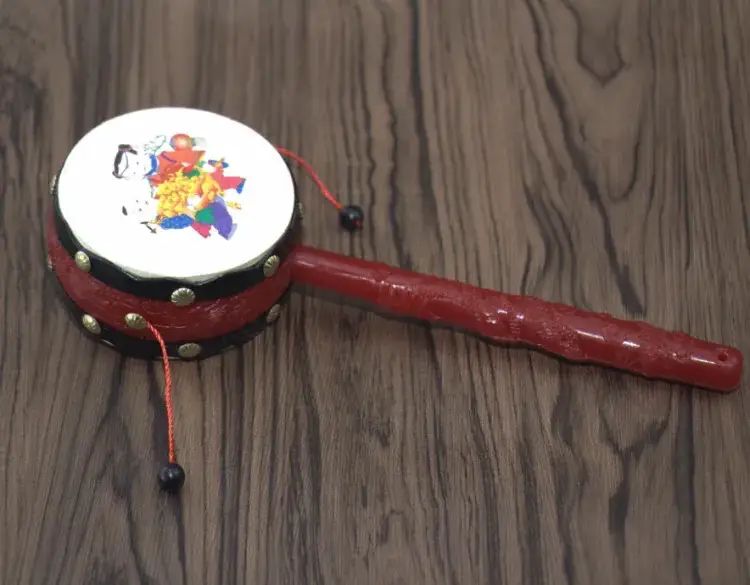
A rattle drum is a percussion instrument that combines the features of a rattle and a drum. During the Warring States era in China, the rattle drum emerged as a popular folk musical instrument and toy. The instrument consists primarily of a tiny drum to which two pellets are attached, one on each side. A sound is produced when the handle is turned and the pellets hit the drum. Drums can have a skin (sheepskin, cowhide, snakeskin, or paper) or a body (wood, bamboo, clay, or hard paper). The most common kind of rattle drum has a wooden body and a drumhead made of sheepskin.
What do Chinese drums symbolize?
The history and cultural significance of Chinese drums go back centuries. Not only do they make beautiful music, but they also represent a wide range of special occasions and events.
The link between Chinese drums and festive occasions is one of their most important metaphorical connotations. A lively and celebratory atmosphere is often created with the help of Chinese drums at traditional festivals, weddings, and other significant rituals. It is thought that the presence of drums at an event will ward off evil spirits and usher in a time of good fortune and prosperity.
The drum is a potent emblem of authority and strength in Chinese culture. Drums were an old form of communication that served to announce major occasions like the arrival of a dignitary or the beginning of battle. During military operations, they were also employed to signal orders to troops. As a symbol of authority and strength, Chinese drums are still played at formal gatherings and political ceremonies today.
Aside from their cultural significance, Chinese drums also play an important role in religious rituals. The beating of the Dharma drum, for instance, denotes the propagation of Buddhist teachings and the reawakening of spiritual awareness, and the drum is used to symbolize this. The drum is played during Taoist exorcism rituals to chase away bad luck and usher in prosperity.
Traditional Chinese medicine also assigns symbolic importance to Chinese drums. According to traditional Chinese medicine, drumming can restore health by reestablishing a healthy flow of qi and chi throughout the body. The idea of sound therapy, in which various sounds are employed to treat various conditions, provides the theoretical foundation for this view.
Lastly, Chinese drums are a representation of national pride and cultural tradition. They play a significant role in the history and tradition of China’s performing arts. As such, they represent a source of national pride for the Chinese people and a link to their cultural past.
drum-shaped stone blocks
Stone drum sculptures, also known as gate drum stones, are a vital component of traditional residential architecture in Fujian and Taiwan. They represent the essence of architectural craftsmanship and are a symbol of the owner’s status and social standing. Along with door ornaments, thresholds, door panels, and frames, stone drum sculptures contribute to an elegant and refined overall aesthetic. They are also imbued with auspicious symbolism, representing good luck, blessings, and protection against evil. Harmonizing with the surrounding architecture, these sculptures add a finishing touch to the entranceway and are an indispensable part of traditional residential architecture.
Common materials for stone drum sculptures include granite, white marble, and bluestone. They serve a functional purpose as part of the residential entranceway and are a feature of Chinese civilization. Also known as embracing drum stones, door drums, spiral drum stones, or door sill stones, these circular sculptures are placed at the threshold or on either side of the entranceway of buildings such as temples, homes, bridges, archways, and gateways. They provide stability and decoration for the structure. The name “stone drum” comes from the drum-like shape that rests on a stone base. The drum face is often decorated with spiral patterns, known as spiral drum stones, as well as dragon and phoenix, flowers, and bird patterns.
Deer are considered a symbol of good fortune. The Chinese character for “deer” sounds like the character for “lu,” which means a high-ranking official or good fortune. Stone drum sculptures are often placed next to the doors of the homes of high-ranking officials. Some sculptures are called “mounting stones,” symbolizing the wish for the homeowner to rise to higher positions of power.
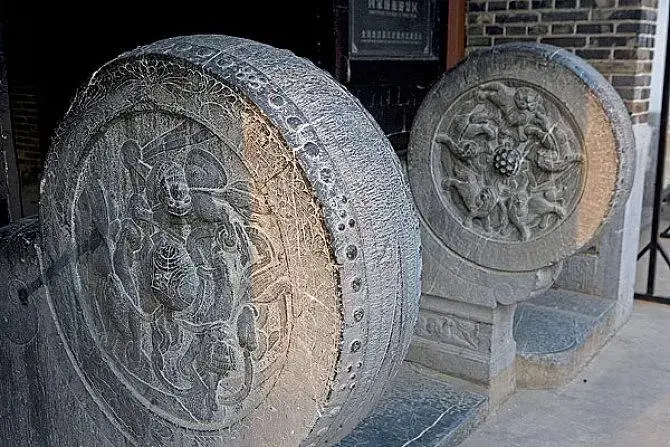
How to play the Chinese drum
Tactics, skills, and stamina all come into play when playing the Chinese drum. What follows are some guidelines for getting started:
The correct way to hold the drum is with both hands and feet shoulder-width apart. Keep your wrists straight and relaxed while you play the drums by holding the sticks firmly in your hands.
Fundamental techniques for playing the Chinese drum’s various drum heads, each of which yields a unique sound, The three basic strokes consist of the center stroke, the rim shot, and the cross-stick. The rim shot is played with a quick flick of the wrist, while the center stroke is played with a full arm motion in the middle of the drumhead. To play a cross-stick, you lay a drumstick across the drumhead and hit it with the other.
The dynamics and tempos of Chinese drumming can range from quiet and delicate to loud and intense. Understanding dynamics requires practicing precise volume and intensity control with each stroke. Similar to dynamics, tempo is the speed of the music, and it is crucial to keep the tempo consistent throughout the performance.
Complex rhythmic patterns are at the foundation of Chinese drumming. Learning these habits and making them part of your routine is crucial. The rhythms typically feature syncopated beats, cross rhythms, and polyrhythms.
Keeping time with the other musicians: Chinese drumming is typically performed in groups, so it’s important to be able to play in time with the other musicians. To pull this off successfully, the performers need to have excellent timing as well as the ability to listen to and understand each other.
Having the stamina and endurance to play the Chinese drum is a test of one’s physical fitness. Besides working on your abs, you should also strengthen your arms, wrists, and hands. Putting in the time and effort to train and exercise on a regular basis will allow you to increase your stamina and resistance to injury.
Chinese drum sticks
In summary, a “guchui” is a tool used to strike drums and suspended cymbals in musical performances. It’s also referred to as a “drumstick” or “drum beater.” Drumsticks can be made from three primary types of wood: walnut, maple, and oak. Oak has the highest density, maple has the lowest. Maple is more prone to wear and plastic deformation, so it’s recommended to choose walnut or oak for better durability.
The Tang Dynasty was a significant period in ancient Chinese history and marked a pinnacle of cultural development. During this era, not only did art and culture flourish, but technological advancements were also made.
The study of drumsticks during the Tang Dynasty is a noteworthy technological achievement. Drumsticks are tools used for grinding and polishing, and during the Tang Dynasty, they underwent improvements and innovations based on traditional techniques.
Research on Tang Dynasty drumsticks garnered widespread attention and praise, standing as a representative achievement of its technological progress. This article delves into the deep exploration of Tang Dynasty drumstick research, aiming to showcase the splendid achievements of Tang Dynasty technology and offer insights for contemporary technological development.
Origins and Development of Tang Dynasty Drumsticks
Tang Dynasty drumsticks played a vital role as a percussion instrument with distinct Tang cultural characteristics. In Tang Dynasty music, drumsticks were extensively used in palace music, folk music, and theatrical performances, serving essential functions.
In palace music, Tang Dynasty drumsticks were indispensable instruments. They often harmonized with other instruments like sheng, guan, pipa, creating splendid melodies for emperors and nobles. Additionally, drumsticks were frequently played alongside large and small drums, contributing to rhythm and ambiance.
Application of Tang Dynasty Drumsticks in Music
Drumsticks also had widespread applications in folk music. In these contexts, drumsticks collaborated with instruments like erhu, yangqin, guzheng, producing diverse melodies and rhythms, bringing joy and entertainment to the populace.
In theatrical performances, Tang Dynasty drumsticks were commonly used instruments. They accompanied other percussion instruments such as gongs and drums, enriching theatrical rhythm and atmosphere. Moreover, drumsticks often coordinated with vocal melodies, enhancing the liveliness of performances.
Military Applications of Tang Dynasty Drumsticks
The military applications of Tang Dynasty drumsticks mainly encompass two aspects:
Firstly, they served as war drums, directing troops during attacks and retreats, boosting morale, and coordinating command and dispatch.
Secondly, they acted as signal devices, transmitting signals within the army for actions like assembly, departure, and halting, facilitating command coordination and communication.
Tang Dynasty armies extensively employed drumsticks in various ways, including striking, waving, and shaking. On the battlefield, the sound of drumsticks conveyed commanders’ intentions, boosting soldiers’ morale and combat capabilities.
Simultaneously, the sound of drumsticks could also confuse enemy forces, making it challenging for them to discern our troops’ actions, leading to unexpected victories.
Application of Tang Dynasty Drumsticks in Ceremonies
Tang Dynasty drumsticks also played a significant role in ceremonial contexts. They were used in the coronation ceremonies of emperors and other important official ceremonies. In coronation ceremonies, the sound of drumsticks conveyed a solemn and authoritative atmosphere, highlighting the emperor’s power and status.
In official meetings and banquets, drumsticks served as signal devices, indicating etiquette actions such as seating, standing, toasting, and more. The distinctiveness and commanding nature of the drumstick’s sound effectively guided guests’ behaviors, maintaining the solemnity and dignity of official etiquette.
Tang Dynasty drumsticks, as both musical and military instruments, held importance not only in their respective domains but also in ceremonial contexts. Their unique sound and forms showcased the unique charm and values of Tang Dynasty culture, influencing the styles and forms of subsequent music, military, and etiquette.
drum-tower
The Drum Tower in China is an ancient architectural structure used to house giant drums for sounding alarms or striking the drum to report the time. Buddhist temples also have Drum Towers, which are built on the left and right sides of the main hall alongside Bell Towers. They are used to hang drums for reporting time or for striking during ceremonies.
Some of the best-preserved Drum Towers in China include the Xi’an Drum Tower, Beijing Drum Tower, and Nanjing Drum Tower.
The functions of the Drum Tower include:
It was used for anti-theft purposes, demonstrating the wisdom of ancient people in notifying others to be vigilant through drumming.
Each village has a Drum Tower to exchange information, fully leveraging the collective strength, setting up a dragnet, making everyone a soldier, and jointly preventing thieves from hiding.
The power of the collective is great. When people are united, they can move mountains.
Conclusion
To sum up, Chinese drums have an extensive past and serve an important function in modern Chinese society. They come in a wide range of materials, styles, and functions and can be seen at a wide variety of shows and events. Drums from China are frequently used in festivities because of the meanings they carry. To master the Chinese drum, one must be patient, dedicated, and practice regularly.